2.main()
{
int i;
unsigned int * px;
unsigned int * py;
unsigned int * pz;
px=(unsigned int *)0x4080;
py=(unsigned int *)0x4100;
for ( i=0,pz=px;i<16;i++,pz++ )
(*pz)=i;
// 字地址,字节地址为 8100H
// 字地址,字节地址为 8200H
for ( i=0,pz=py;i<16;i++,pz++ )
// 在此加软件断点
(*pz)=0x1234;
for ( i=0;i<16;i++,px++,py++ )
// 在此加软件断点
(*py)=(*px);
while(1)
{
}
// 在此加软件断点
}
3.#include "myapp.h"
// 定义指示灯寄存器地址和寄存器类型
#define LBDS (*((unsigned int *)0x400001))
void INTR_init( void );
void TIMER_init(void);
int nCount;
main()
{
nCount=0;
PLL_Init(40);
SDRAM_init();
LBDS=0;
INTR_init();
TIMER_init();
while ( 1 )
{
}
}
�
void interrupt Timer()
{
nCount++; nCount%=16;
if ( nCount==0 )
LBDS^=1;
}
void INTR_init( void )
{
IVPD=0xd0;
IVPH=0xd0;
IER0=0x10;
DBIER0 =0x10;
IFR0=0xffff;
asm(" BCLR INTM");
}
void TIMER_init(void)
{
ioport unsigned int *tim0;
ioport unsigned int *prd0;
ioport unsigned int *tcr0;
ioport unsigned int *prsc0;
tim0 = (unsigned int *)0x1000;
prd0 = (unsigned int *)0x1001;
tcr0 = (unsigned int *)0x1002;
prsc0 = (unsigned int *)0x1003;
*tcr0 = 0x04f0;
*tim0 = 0;
*prd0 = 0x0ffff;
*prsc0 = 2;
*tcr0 = 0x00e0;
}
4.#include "myapp.h"
#include "ICETEK-VC5509-EDU.h"
#include "scancode.h"
void InitADC();
void wait( unsigned int cycles );
void EnableAPLL( );
unsigned int nADC0[256],nADC1[256];
main()
{
�
int i;
unsigned int uWork;
EnableAPLL();
SDRAM_init();
InitADC();
PLL_Init(132);
while ( 1 )
{
for ( i=0;i<256;i++ )
{
ADCCTL=0x8000; // 启动 AD 转换,通道 0
do
{
uWork=ADCDATA;
} while ( uWork&0x8000 );
nADC0[i]=uWork&0x0fff;
}
for ( i=0;i<256;i++ )
{
ADCCTL=0x9000; // 启动 AD 转换,通道 1
do
{
uWork=ADCDATA;
} while ( uWork&0x8000 );
nADC1[i]=uWork&0x0fff;
}
asm( " nop");
// break point
}
}
void InitADC()
{
ADCCLKCTL=0x23; // 4MHz ADCLK
ADCCLKDIV=0x4f00;
}
void wait( unsigned int cycles )
{
int i;
for ( i = 0 ; i < cycles ; i++ ){ }
}
void EnableAPLL( )
�
{
/* Enusre DPLL is running */
*( ioport volatile unsigned short* )0x1f00 = 4;
wait( 25 );
*( ioport volatile unsigned short* )0x1f00 = 0;
// MULITPLY
*( ioport volatile unsigned short* )0x1f00 = 0x3000;
// COUNT
*( ioport volatile unsigned short* )0x1f00 |= 0x4F8;
wait( 25 );
//*( ioport volatile unsigned short* )0x1f00 |= 0x800
// MODE
*( ioport volatile unsigned short* )0x1f00 |= 2;
wait( 30000 );
// APLL Select
*( ioport volatile unsigned short* )0x1e80 = 1;
// DELAY
wait( 60000 );
}
5.#include "myapp.h"
#include "ICETEK-VC5509-EDU.h"
#include "scancode.h"
#define CTRSTATUS (*(unsigned int *)0x600800) //port8000
#define CTRLED (*(unsigned int *)0x600802) // port8004
void InitMcBSP();
main()
{
PLL_Init(12);
SDRAM_init();
InitCTR();
InitMcBSP();
�
CTRSTATUS=0x80;
CTRSTATUS=0;
CTRSTATUS=0x80;
CTRSTATUS=0;
CTRLED=0xff;
// 使能 IO
CTRGR=2;
while ( 1 )
{
PCR1^=8;
Delay(256);
}
}
void InitMcBSP()
{
// IOPin: McBSP1.FSX S15
//SPCR2.XRST_=0,PCR.XIOEN=1,PCR.FSXM=1,PCR.FSXP=0/1
SPCR2_1&=0x0fffe;
PCR1|=0x2800;
}
6.#include
#include "volume.h"
/* processing data buffers */
/* Global declarations */
int inp1_buffer[BUFSIZE];
int inp2_buffer[BUFSIZE];
int out1_buffer[BUFSIZE];
int out2_buffer[BUFSIZE];
int out3_buffer[BUFSIZE];
int out4_buffer[BUFSIZE*2];
int size = BUFSIZE;
int ain = MINGAIN;
int zhy=0;
int sk=64;
点,sine11.dat,
/*sk 代 表 所 开 的 bufsize 的 大 小, 需 修 改 它 . 输 入 文 件 sine.dat 为 32
sin22.dat,sin33.dat,sin44.dat 为 64 点的输入波形.*/
/* volume control variable */
//unsigned int processingLoad = 1;
/* processing routine load value */
�
/* Functions */
extern void load(unsigned int loadValue);
static int processing1(int *output1, int *output2);
static int processing2(int *output2, int *output3);
static int processing3(int *input1,int *output2,int *output4);
static int processing4(int *input2, int *output1);
static void dataIO1(void);
static void dataIO2(void);
/*
* ======== main ========
*/
void main()
{
int *input1 = &inp1_buffer[0];
int *input2 = &inp2_buffer[0];
int *output1 = &out1_buffer[0];
int *output2 = &out2_buffer[0];
int *output3 = &out3_buffer[0];
int *output4 = &out4_buffer[0];
puts("volume example started\n");
/* loop forever */
while(TRUE)
{
/*
* Read input data using a probe-point connected to a host file.
* Write output data to a graph connected through a probe-point.
*/
// break point
// break point
dataIO1();
dataIO2();
/* apply gain */
processing4(input2,output1);
processing1(output1, output2);
processing2(output2, output3);
processing3(input1,output2,output4) ;
}
}
/*
* ======== processing ========
*
�
* FUNCTION: apply signal processing transform to input signal.
*
* PARAMETERS: address of input and output buffers.
*
* RETURN VALUE: TRUE.
*/
static int processing4(int *input2,int *output1)
{
int m=sk;
for(;m>=0;m--)
{
*output1++ = *input2++ * ain;
}
for(;(size-m)>0;m++)
{output1[m]=0;
}
//
load(processingLoad);
return(TRUE);
}
static int processing1(int *output1,int *output2)
{
int m=sk-1;
for(;m>0;m--)
{
*output2++ = *output1++ * ain;
}
//
/* additional processing load */
load(processingLoad);
return(TRUE);
}
static int processing2(int *output2, int *output3)
{
int n=zhy;
size=BUFSIZE;
for(;(size-n)>0;n++)
{ *output3++ = output2[n];
}
/* for (;n>0;n--)
{ *output3++ = 0;
}
*/
//
load(processingLoad);
return(TRUE);
�
}
static int processing3(int *input1,int *output2,int *output4)
{
int m=sk;
int y=zhy;
int z,x,w,i,f,g;
for(;(m-y)>0;)
{i=y;
x=0;
z=0;
f=y;
for(;i>=0;i--)
{g=input1[z]*output2[f];
x=x+g;
z++;
f--;
}
*output4++ = x;
y++;
}
m=sk;
y=sk-1;
w=m-zhy-1;
for(;m>0;m--)
{
y--;
i=y;
z=sk-1;
x=0;
f=sk-y;
for(;i>0;i--,z--,f++)
{g=input1[z]*output2[f];
x=x+g;
}
out4_buffer[w]=x;
w++;
}
//
load(processingLoad);
return(TRUE);
}
/*
* ======== dataIO ========
*
* FUNCTION: read input signal and write processed output signal.
�
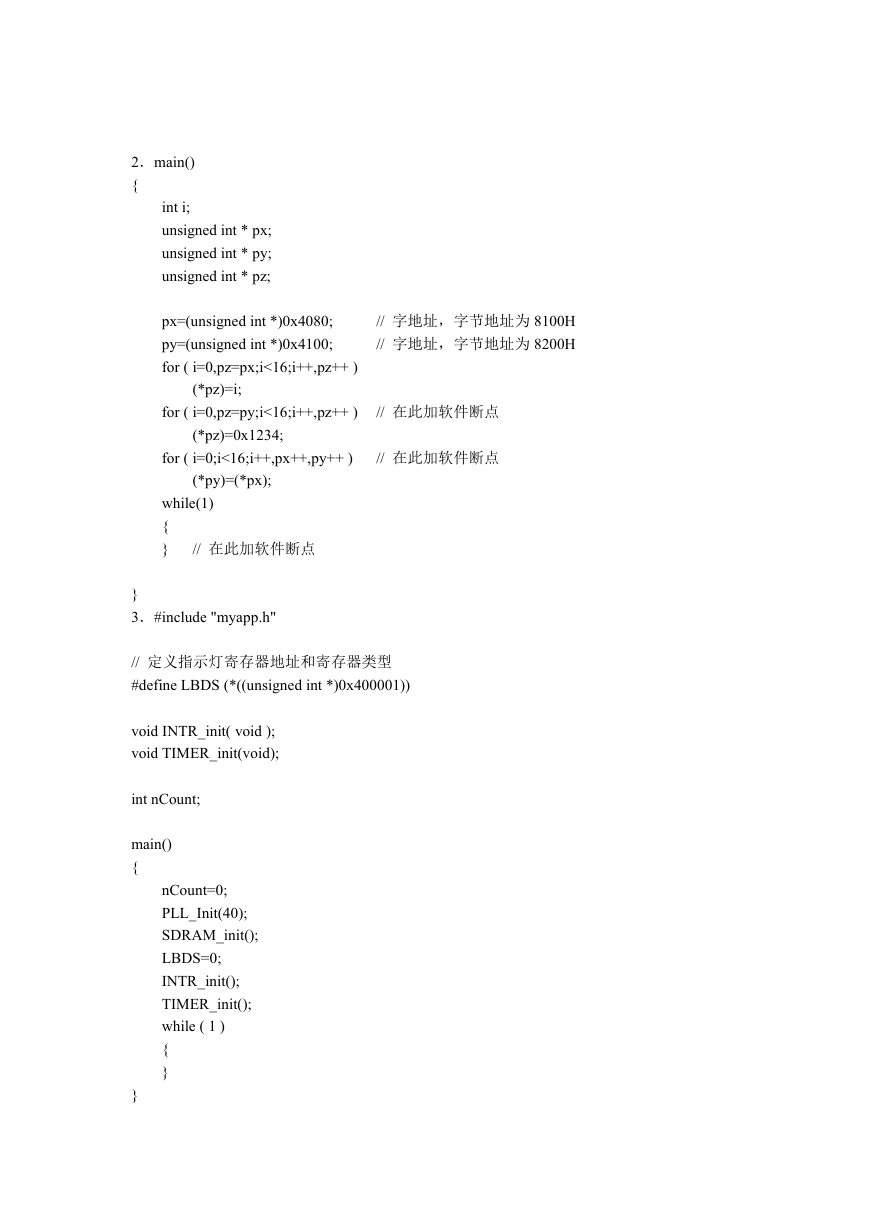
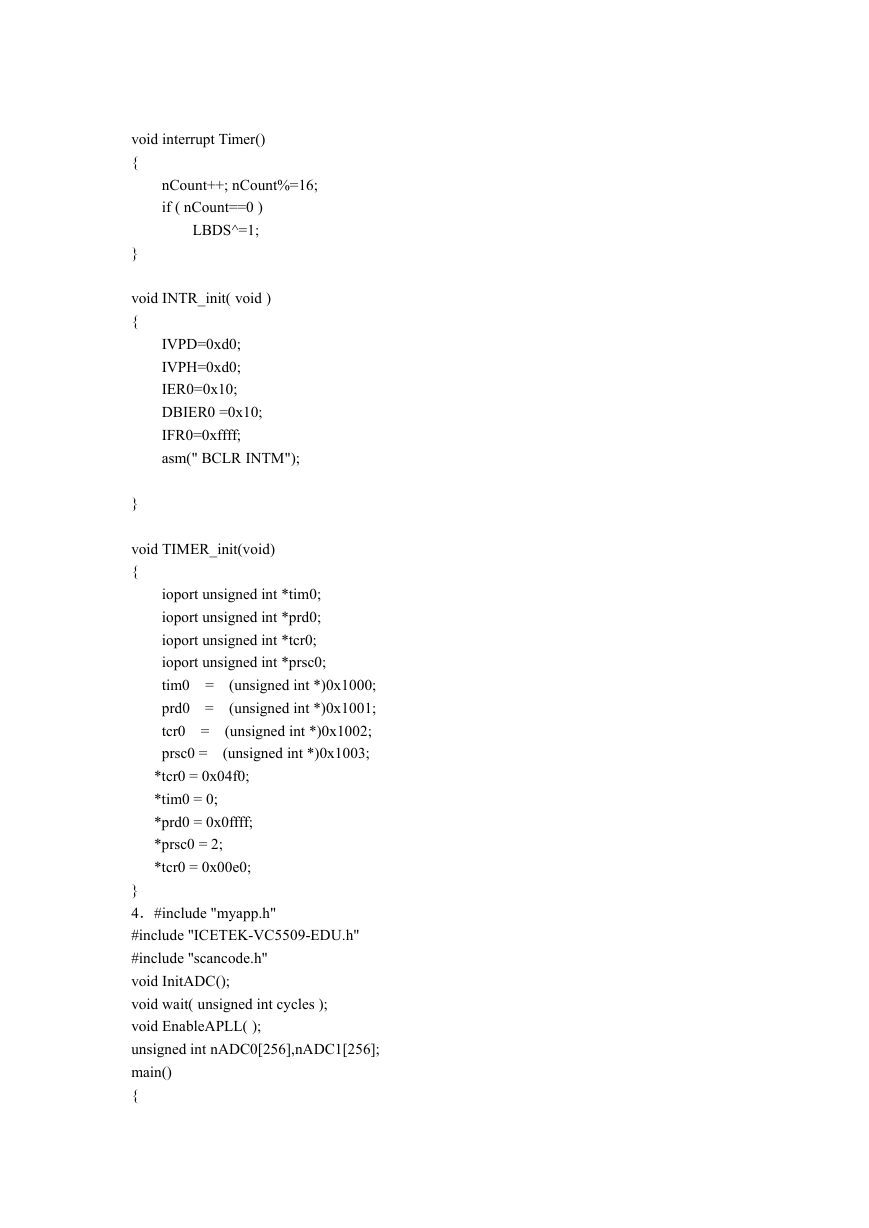
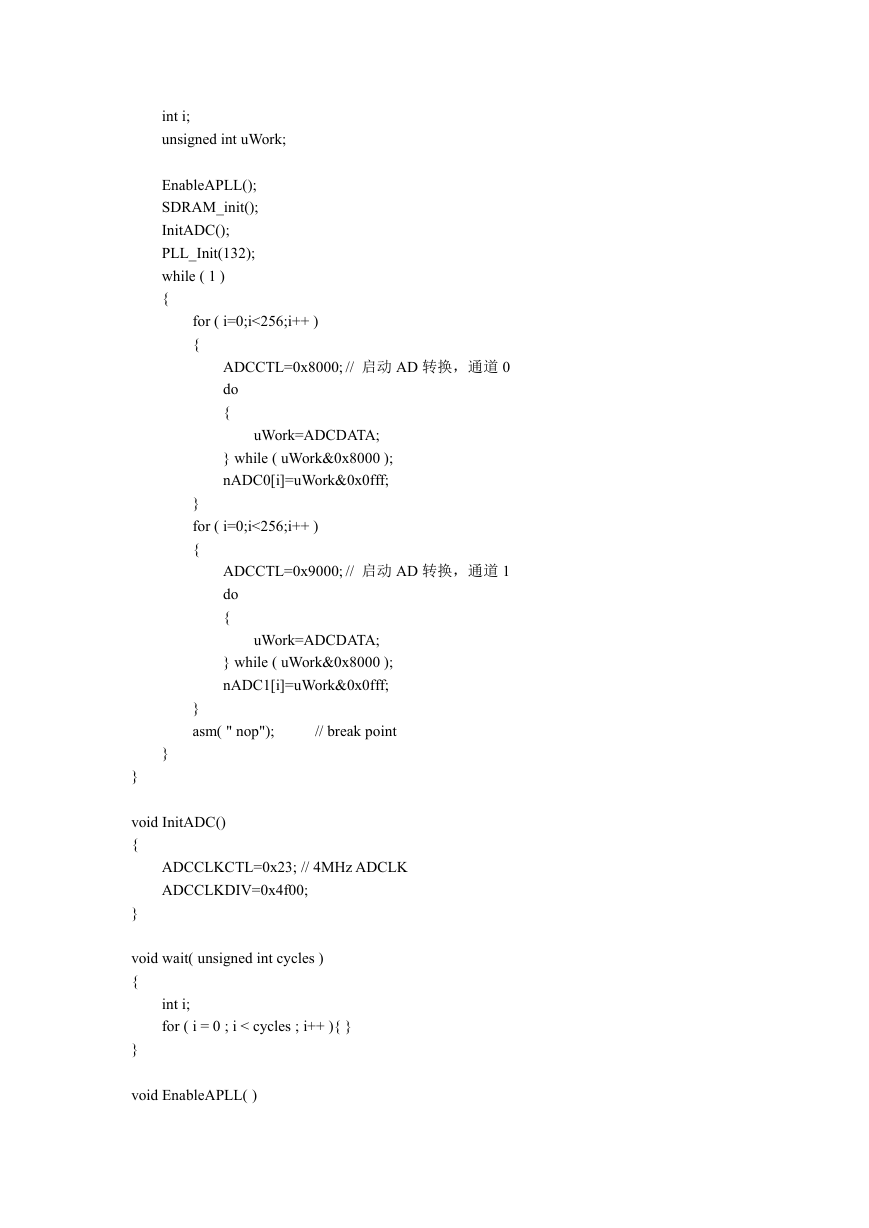
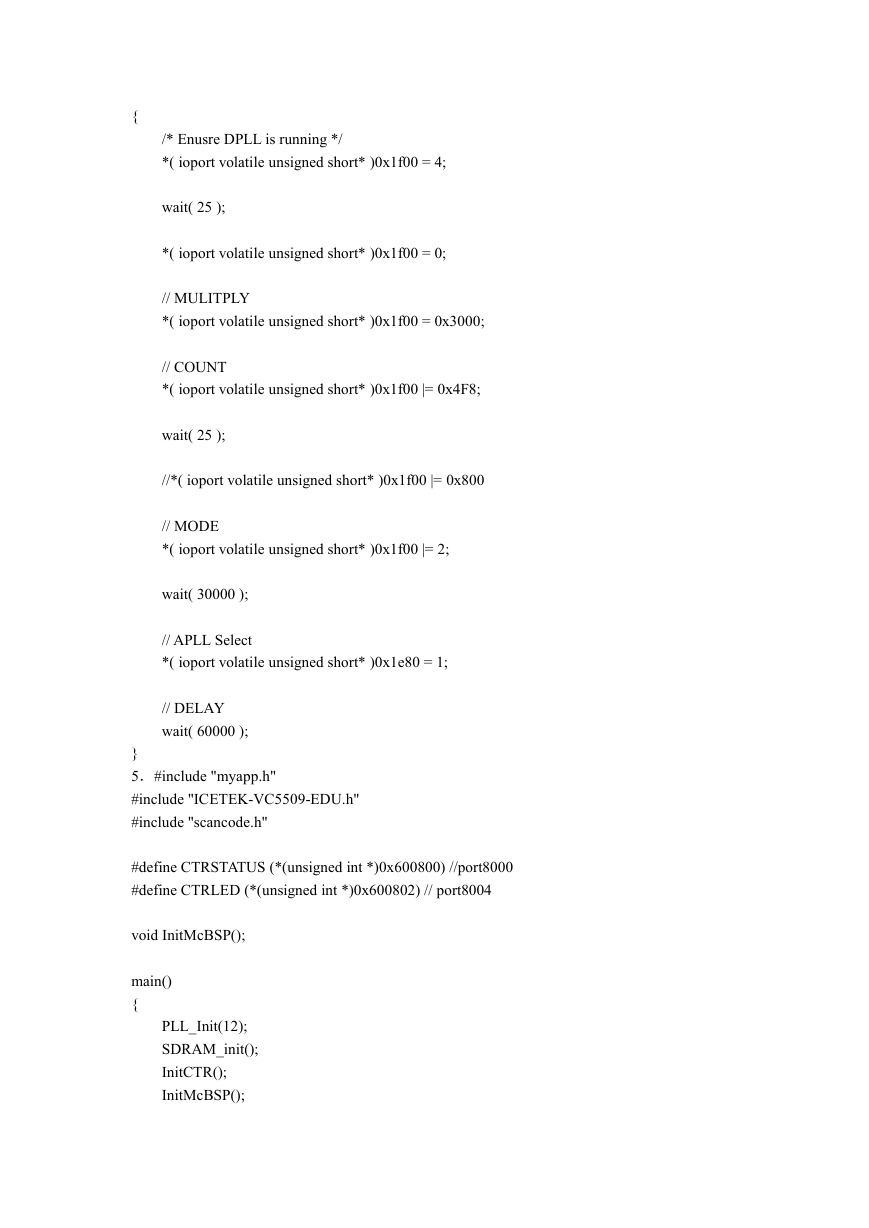
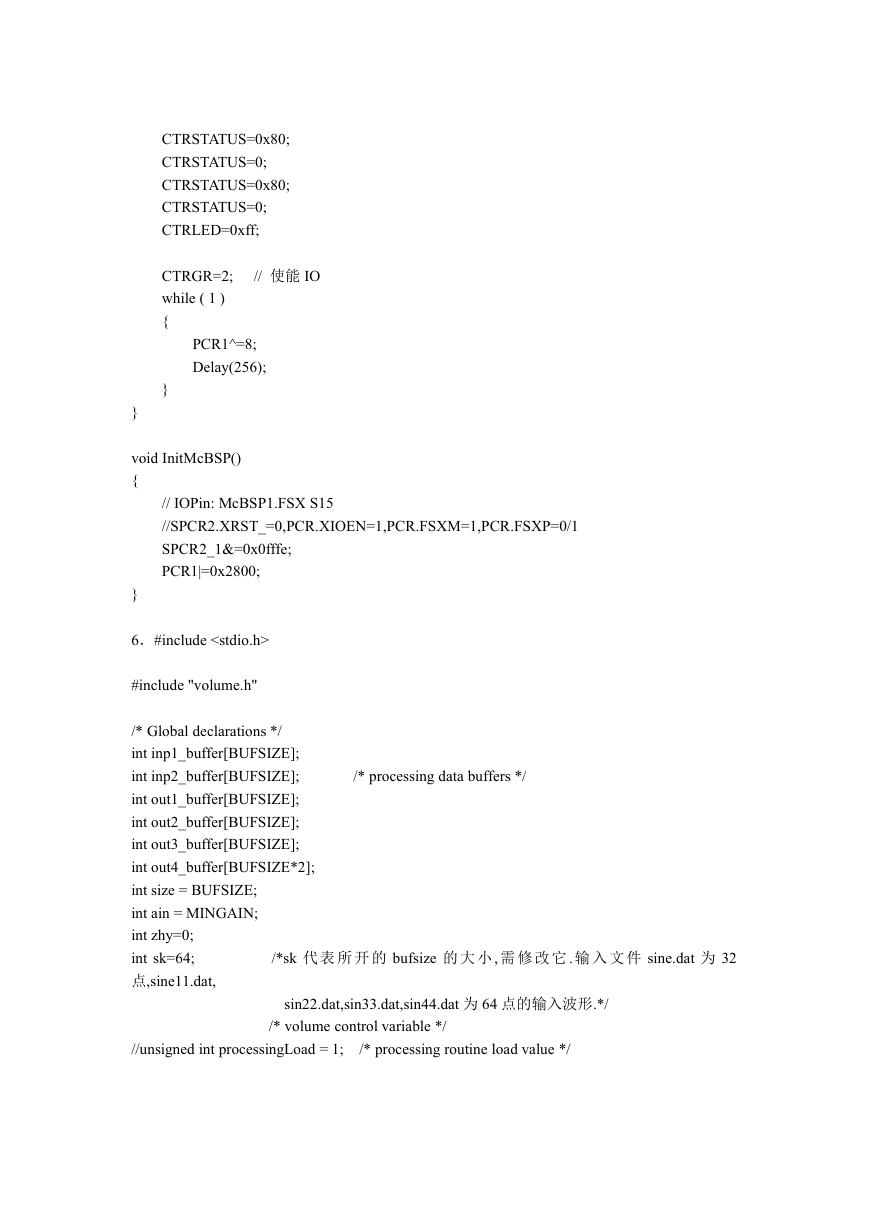

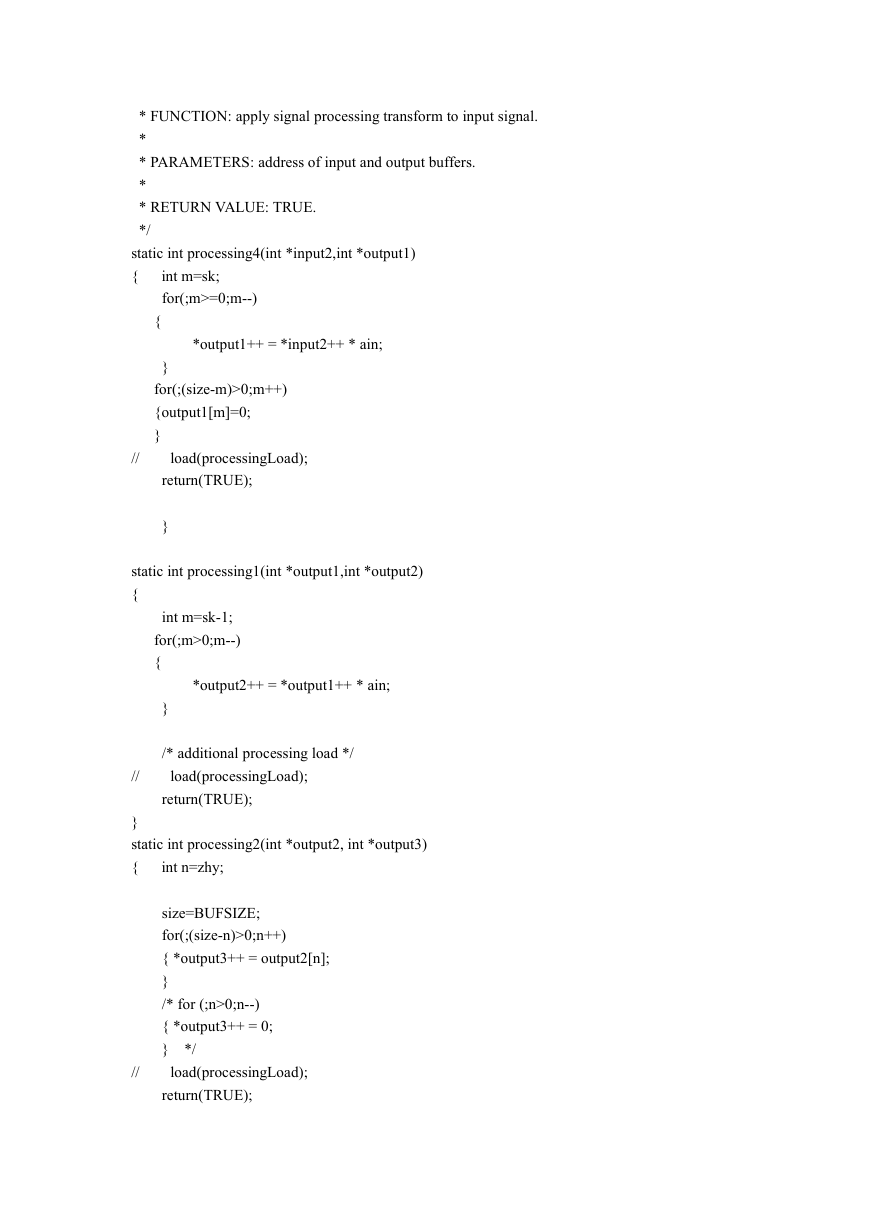
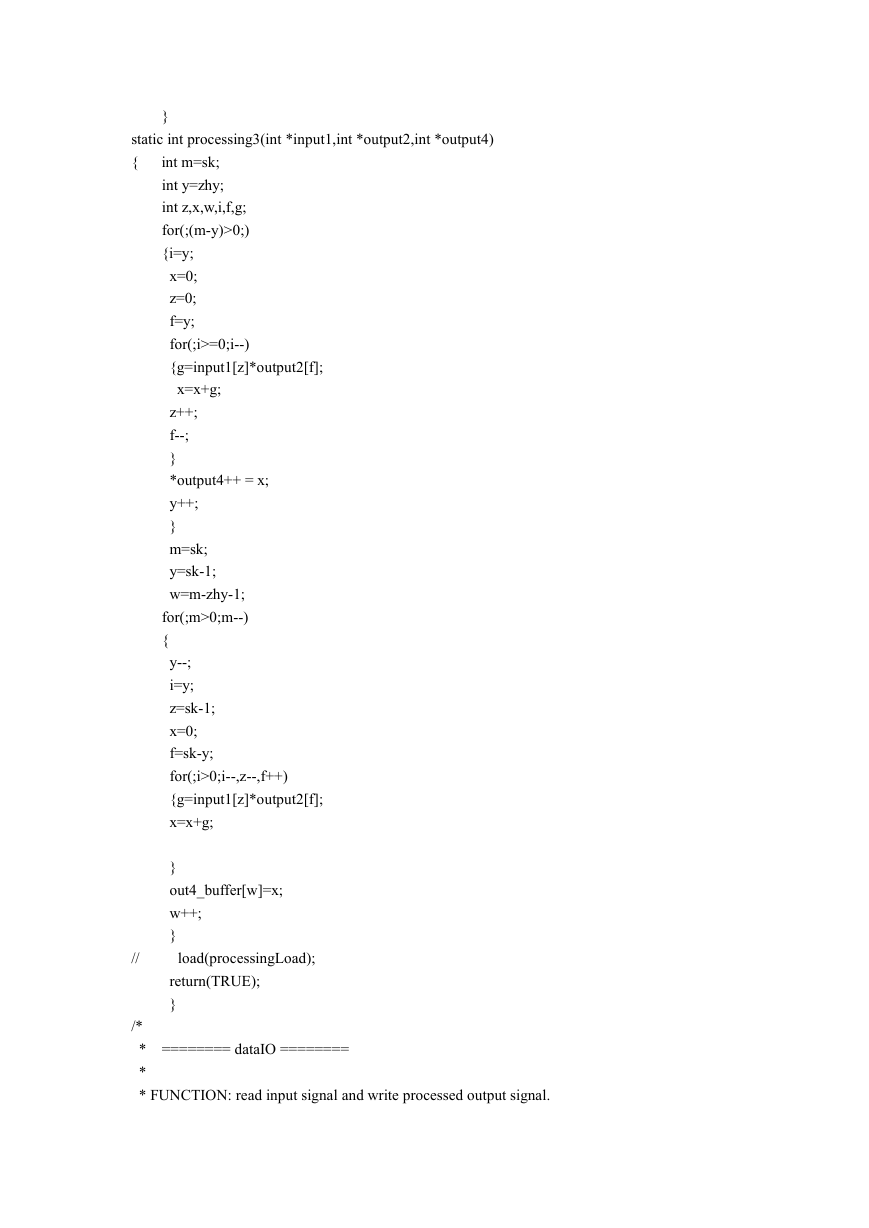








 2023年江西萍乡中考道德与法治真题及答案.doc
2023年江西萍乡中考道德与法治真题及答案.doc 2012年重庆南川中考生物真题及答案.doc
2012年重庆南川中考生物真题及答案.doc 2013年江西师范大学地理学综合及文艺理论基础考研真题.doc
2013年江西师范大学地理学综合及文艺理论基础考研真题.doc 2020年四川甘孜小升初语文真题及答案I卷.doc
2020年四川甘孜小升初语文真题及答案I卷.doc 2020年注册岩土工程师专业基础考试真题及答案.doc
2020年注册岩土工程师专业基础考试真题及答案.doc 2023-2024学年福建省厦门市九年级上学期数学月考试题及答案.doc
2023-2024学年福建省厦门市九年级上学期数学月考试题及答案.doc 2021-2022学年辽宁省沈阳市大东区九年级上学期语文期末试题及答案.doc
2021-2022学年辽宁省沈阳市大东区九年级上学期语文期末试题及答案.doc 2022-2023学年北京东城区初三第一学期物理期末试卷及答案.doc
2022-2023学年北京东城区初三第一学期物理期末试卷及答案.doc 2018上半年江西教师资格初中地理学科知识与教学能力真题及答案.doc
2018上半年江西教师资格初中地理学科知识与教学能力真题及答案.doc 2012年河北国家公务员申论考试真题及答案-省级.doc
2012年河北国家公务员申论考试真题及答案-省级.doc 2020-2021学年江苏省扬州市江都区邵樊片九年级上学期数学第一次质量检测试题及答案.doc
2020-2021学年江苏省扬州市江都区邵樊片九年级上学期数学第一次质量检测试题及答案.doc 2022下半年黑龙江教师资格证中学综合素质真题及答案.doc
2022下半年黑龙江教师资格证中学综合素质真题及答案.doc